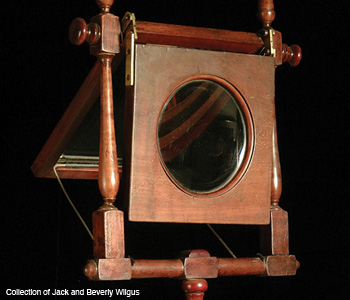Light Touch
Zograscopes: An 18th Century Perspective on 3-D Imaging
So-called perspective machines were popular parlor amusements in the 18th and 19th centuries. Also known as zograscopes or boites d’optique, these devices brought flat images to life in the days before stereoscopic imaging.

If you visit Boston’s Museum of Fine Arts, you’ll find a curious piece in the 18th century section of the new Art of the Americas wing. It appears to be a five foot tall stubby obelisk of painted wood, with a large cameo-like carving on the front, which is believed to be the work of woodcarver and architect Samuel McIntire of Salem. If you move this carving aside, you will reveal a single large lens, about eight inches in diameter—an odd thing to find on a piece of 18th century furniture. The placard identifies it as a “perspective machine.” This is not the device of that name used by Albrecht Durer and others to properly project an object into a perspective view; rather, it was a popular form of entertainment in the 1700s and 1800s.
…Log in or become a member to view the full text of this article.
This article may be available for purchase via the search at Optica Publishing Group.
Optica Members get the full text of Optics & Photonics News, plus a variety of other member benefits.
